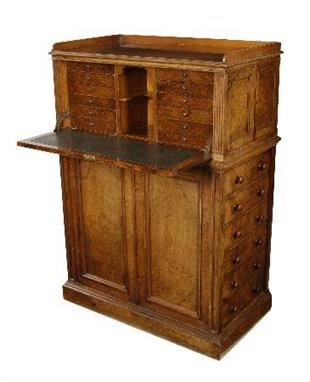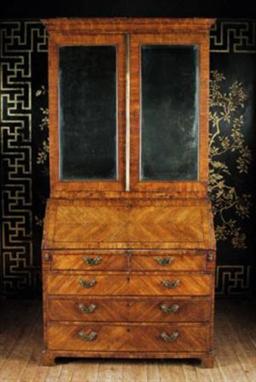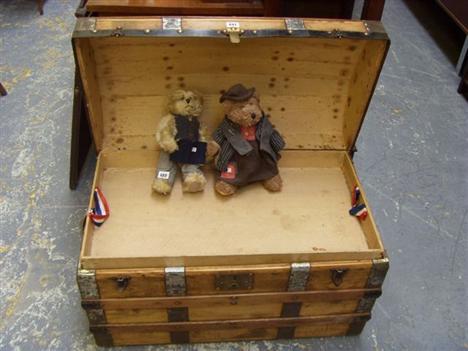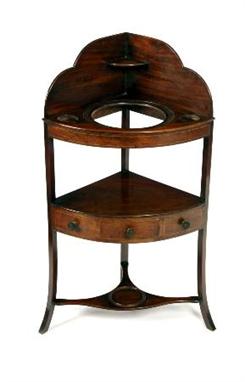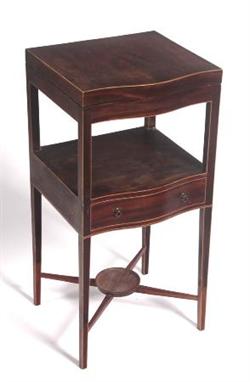A French carved walnut buffet a deux corps in Renaissance style, by C. Sornay & Fils, the detachable pediment above a moulded and dentil cornice with a tablet and leaf frieze, above a pair of doors decorated with grotesques and Francis I`s motif the salamander, enclosing an adjustable shelf, flanked by a pair of fluted and trailing vine carved columns, the conforming base to bun feet, the back with a stencilled mark `AMEUBLEMENTS, C. SORNAY & FILS, Lyon`, late 19th century, 81.25in (206.2cm) h, 39in (98.7cm) w, 19.5in (49.7cm) d.
We found 104473 price guide item(s) matching your search
There are 104473 lots that match your search criteria. Subscribe now to get instant access to the full price guide service.
Click here to subscribe- List
- Grid
-
104473 item(s)/page
A Victorian burr walnut cabinet, the moulded edge top inset a hinged compartment and with a 3/4 gallery above a self locking leather lined fall, the interior with an arrangement of eleven plush lined drawers and a recess to house possibly a microscope, the base with two doors the left enclosing a shelf, the right side of the cabinet with six drawers and a locking bar, the left side with dummy drawers, to a plinth base, 48.5in (123.4cm) h, 34.75in (88cm) w, 19in (48cm) d.
A 19th Century French gilt framed three tier wall shelf with bevelled mirror panel to back, the arched top with fretted leaf scroll cresting, oval bead and floral carved frame and shaped shelf edgings, with two turned uprights, and oval cartouche and leaf scroll carved apron, 18ins wide x 43ins high
An oak livery cupboard, the upper part with egg and dart carved edge and applied mouldings to frieze, fitted one shelf enclosed by a pair of doors with turned spindles and inlaid panels, the lower part fitted cupboard enclosed by a single panelled door, 34ins wide x 11ins deep x 33ins high (lacking upstand)
A late Victorian mahogany side cabinet, the upper part with shaped and scroll carved cresting, fitted one cloth covered shelf enclosed by a single glazed door with shaped glazing bars, flanked by open shelves, on slender turned supports and inset with bevelled mirror panels, the serpentine fronted base with moulded edge, fitted one frieze drawer with blind fret carved panels, on four square tapered and moulded legs with reeded square toes, 33ins wide x 19ins deep x 66ins high
A William IV figured mahogany bookcase, the upper part with scroll shaped pediment carved with reeded ornament and flowerhead paterae, fitted eight shelves enclosed by a pair of glazed doors, the base with moulded edge to top, fitted one shelf enclosed by a pair of panelled doors, on bold carved paw feet, 56ins wide x 23ins deep x 109ins high
Late C19th Mahogany Art Nouveau Sideboard, faceted front with bevelled glass doors, door to centre with 4 panelled domed bevelled glass top, pair of side panels, matching raised on square section club footed supports, top section with pierced tapering square section columns, bevelled glass mirror with carved Art Nouveau foliage with fretted end supports, secondary shelf with bevelled glass mirror plates under a carved canopy
Faraday Experimental Chemistry and Physics first edition half-title 3 plates 1 folding marginal spotting ex-Farraday House Library with bookplates and ink stamp to title front pastedown and fore-edge bookplates of Hugh Erat Harrison original cloth spine gilt and with gilt shelf number at foot a little fraying to corners but generally in very good condition 8vo Richard Taylor and William Francis 1859.
Faraday Experimental Researches Electricity 3 vol. first collected edition vol.1&2 facsimile reprints vol.3 first edition folding plates ex-Faraday House Library with bookplates bookplates of Hugh Erat Harrison original green cloth spines gilt and with gilt shelf number at foot labels removed from spines leaving faint marks vol.2 very small hole at foot rubbed at extremities in all still a good set 8vo 1859. ***Hugh Erat Harrison was the first principal of Faraday House.
Maxwell Electrical Henry Cavendish... edited from the original manuscripts in the possession of the Duke of Devonshire first edition half-title facsimile plates of Cavendish`s writings 1p. advertisement at end ex-Farraday House Library with bookplate bookplate of Hugh Erat Harrison original cloth spine gilt and with gilt shelf number label removed from spine leaving mark Cambridge 1879; and another about Cavendish 8vo(2)
A Dutch mahogany and marquetry display cabinet, early 19th century, inlaid overall with stained sycamore and fruitwood birds, foliage and urns, the shaped cornice with canted angles, over a pair of glazed fielded panel doors enclosing two shelves, above a pair of fielded panel doors enclosing one shelf, upon a plinth base and later castors, 201 x 136 x 32 cm.
A fine quality reproduction Mahogany Sheraton Revival Side Cabinet, with central raised scrolled pediment, applied with carved heads, over a convex mirror, flanked on either side by glass panelled bow fronted cupboards, with a shaped frieze below with long central drawer flanked by two curved fronted short drawers, with a recessed central cupboard under, flanked on either side by further reeded doors, enclosing a cupboard, raised on six foliate moulded and reeded tapering supports joined by a full width open shelf and profusely inlaid throughout in the Sheraton manner with neo-classical urns, scrolls and foliage etc, 64” wide, 86” high
A fine George III mahogany bureau cabinet, of architectural form, the boldly worked swan neck cornice over a single mirrored door with a gilt leaf carved slip, flanked by tapering square pilasters over candle slides. The interior with pigeon holes, an adjustable shelf and small cockbeaded drawers around a central locking cupboard. The fall front opening to reveal pigeon holes, drawers and a cupboard over two short and three long graduated drawers, with original brass handles, pierced back plates and heavy carrying handles on ogee bracket feet, 88.5cm wide, 54cm deep, 222cm high
An extraordinary George II cocuswod bureau bookcase, c.1730, the delicate cavetto cornice over a pair of mirrored doors with bevelled plates, opening to reveal a large central cupboard flanked by pigeon holes, three small drawers and an adjustable shelf over candle slides. The bureau interior with drawers and pigeon holes over two short and three long graduated drawers with moulded edges, original brass handles, batwing back plates and bracket feet, 110cm wide, 57.5cm deep, 219cm high. Cocus wood (Brya ebenus), also called granadillo and Jamaica ebony, was imported from the West Indies from the mid 17th century onwards. It is produced by a small tree, rarely more than 8" (20cm.) in diameter and, when fresh, has a deep chocolate-brown heart with a yellow sapwood. It fades quickly to the muted colours seen on the present lot, and until recently was generally mistaken for laburnum. It was typically a turner`s wood, much used for the manufacture of clarinets and other wind instruments, including for the chanters of Scottish bagpipes. In the late 17th century cocus was commonly employed for `oyster` veneered cabinets, tables and other furniture. It was less favoured by 18th century furniture makers, but Pembroke tables, card tables, bureaux and desks of cocus are known to survive. These are generally veneered, as in the present case, with narrow longitudinally cut veneers arranged to create a striking visual effect.
A 19th century mahogany corner wash stand with graduated splash back over three wells, boxwood strung frieze panel, open shelf with a single short drawer, flanked by dummy drawers, raised on square legs terminating in splayed feet, united by a T-shaped stretcher 67cm wide, 104cm high, 43cm deep
-
104473 item(s)/page




